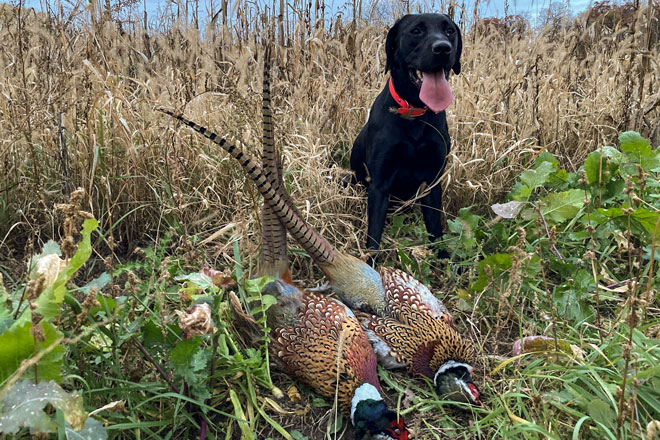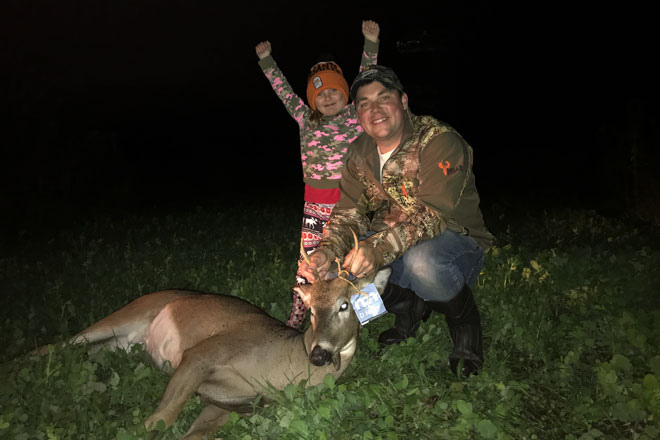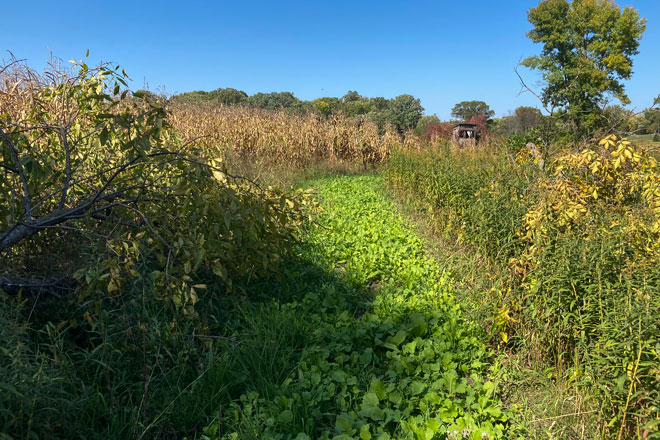Managing for wildlife on a pocket-sized property
Story and photos by Jared Wiklund
My wife assures me that I have an addiction. Sometimes my kids think I’ve jumped off the deep end. Pheasants Forever colleagues label it a fixation. I’d describe myself as a junkie. And the only therapy is more habitat. Hello, my name is Jared and I am a small acreage habitat junkie.
THE HABITAT LIFESTYLE
My obsession for wildlife habitat management started 20 years ago at our cabin property (which doubled as deer camp) in Wisconsin, and became fully fledged in 2014 when my wife and I purchased our current acreage in east-central Minnesota. Not unlike the majority of Pheasants Forever members nationwide, a house and small habitat mosaic are what we could comfortably afford.
The house was (still is) great. The 10 acres of “habitat” required a savior.
The best habitat projects force managers to see things not for what they are, but for what they could be. The brome grass “prairie” and buckthorn-infested “timber” was uninviting for wildlife. My small acreage dilemma was offset by adjacent good habitat, and a fortuitous public lands surprise (see sidebar below).
Seven years and infinite applications of elbow grease later (as well as financial investments for equipment — yes, another addiction), I’ve transformed our small acreage into a productive habitat oasis whose wildlife encounters never cease to amaze, and where traditions of prairie-to-plate wild game harvests are renewed each year.
Pocket-sized properties can and do play a role in wildlife management. Maybe you’ve got 10 acres, or maybe it’s 40. Let me offer a list of trial-and-error habitat lessons I’ve gleaned as a small acreage property owner.
 A productive habitat oasis
A productive habitat oasis
DETERMINE YOUR HABITAT AND WILDLIFE OBJECTIVES
Our acreage was purchased in the dead of winter, which gave me a few precious months to take stock of existing wildlife, plants and trees, and come up with a plan to start transforming the property.
Ring-necked pheasants weren’t plentiful upon our arrival, but they did exist. Per usual across the pheasant range, nesting cover was a limiting factor.
On the other hand, white-tailed deer and wild turkeys were common.
Part of a woodlot had some marshy habitat: When coupled with numerous cattail swamps and open water on surrounding acres, the wood duck population seemed good.
My habitat plan was quite simple: Manage for upland bird habitat where possible, and the other species will follow. That’s the beautiful part about PF’s namesake, the king of upland birds: Pheasant habitat management efforts equate to other recreational interests, namely deer and gobblers.
 Manage for upland bird habitat where possible, and the other species will follow.
Manage for upland bird habitat where possible, and the other species will follow.
THE PUBLIC LAND PLAY
For individuals actively seeking a move to the country lifestyle, securing a new estate directly adjacent to public lands can significantly increase the opportunity to view, manage and recreate for wildlife in your own “backyard.”
This is where real estate research comes into play. Take time to cross-reference property search results with an application such as onX Hunt to help identify nearby federal, state or county property that is protected in perpetuity.
Our house and property border a 500-acre wildlife management area that wasn’t disclosed in any real estate description. I figured it out for myself, and you can too.
 Pheasant habitat management efforts equate to other recreational interests, namely deer and gobblers.
Pheasant habitat management efforts equate to other recreational interests, namely deer and gobblers.
MANAGE WOODY ENCROACHMENT
Any neglected grassland landscape will have issues with woody encroachment. That’s the nature of succession on the prairie.
With a few acres of timber already serving as a refuge for whitetails and turkeys, the first order of business for my rooster revival was the removal of prickly ash brush and green ash trees among the remnants of big bluestem, Indiangrass and the few forb species I could identify. (Note: The Picture This Plant ID App has been a game changer for me in this regard.)
Countless hours spent utilizing the “cut stump” treatment on prickly ash — shearing close to ground level and applying Triclopyr herbicide (sold under the trade name of Garlon 4) — yielded excellent results for this tough-to-kill prairie competitor. Similar multi-year efforts will be required inside the timberline for invasive buckthorn treatment (as seen in the prairie/timber panorama below), allowing sunlight to reach the forest floor for native shrub regeneration.
Likewise, numerous green ash trees exceeding 8 inches in diameter were hinge cut — sawing halfway through at a 45-degree angle to fell a tree with a percentage of trunk still attached — to provide wildlife browse at ground level while creating a living, horizontal habitat structure for summer pheasant broods and winter cottontails.
In addition to removing undesirable species, I’ve begun the process of planting a small shelterbelt consisting of short stature evergreens, red osier dogwoods and serviceberry shrubs along my fenceline: excellent, wildlife-friendly additions to my habitat mosaic. The plants were acquired free of charge from my county conservation district.
UTILIZE PRESCRIBED FIRE
In terms of revitalizing habitat and making the most of grassland potential, prescribed fire is a prairie’s best friend. Getting the proper certificates and writing burn plans is not for the faint of heart through. It took me several years to reach a comfort level that allowed for prescribed fire to be utilized with a motley crew and the correct equipment. Contact Pheasants Forever as a great resource for prescribed fire training and information.
Half of my pocket-sized property is burned every other year to revitalize pollinator species, set back cool-season grasses, remove duff layers, and quickly neutralize any woody plants that creep into the prairie’s edge.
Likewise, our local chapter of Pheasants Forever supported a matching grant for tree removal and planned prescribed fire every three years on the adjacent public lands — an Adopt a Wildlife Area program put to work in my local region. The neighborhood pheasant population has had a strong response.
EQUIPMENT INNOVATION
My initial equipment arsenal consisted of a chainsaw, a hand pump sprayer and a lawnmower. In terms of habitat manipulation, this setup received a failing grade.
As my list of ambitious habitat projects increased — prescribed burns, food plot, shrub plantings, brush mowing — I had to get innovative with my meager “equipment fund.”
I turned to Facebook Marketplace and Craigslist with much success. You’d be surprised at the number of utility tractor operators who have all the necessary equipment available for habitat projects at a nominal fee. I have hired out tilling, spraying, mowing, hole augers and no-till drills to accomplish my prairie goals for less than a thousand dollars with phenomenal results. Compared to equipment costs, that’s cents on the dollar.
The main point: whether utilizing neighbors or hired help, don’t use lack of equipment as an excuse for deviating from your plan. Beg, borrow, hire, and if you can get a deal that pays back, buy. Just look outside the box.
IDENTIFYING THE X-FACTOR
After several years restoration with prescribed fire, herbicide treatments, interseeding of forbs and tree removal, our family noticed an uptick in wildlife encounters thanks to the habitat diversity at hand. But by mid-November my favorite quarry to hunt — pheasants and whitetails — seemingly disappeared from the face of the earth.
I was missing the x-factor.
Where I reside, the landscape is dominated by wetlands and lowland brush, with relatively few agricultural options available for wildlife in the late season. My incredible neighbors and fellow hunters, the dairy farmers, had a monopoly on winter wildlife populations thanks to a huge cattle yard and the only grain stubble in two square miles.
So I plugged and played with numerous food options for wildlife including sorghum, sunflowers, millet, Rooster Booster Signature Series mix, rapeseed and others. It’s not a one-size-fits-all approach. In my situation, the combination of corn (30-inch rows) interseeded in mid-August with winter rye and Pheasants Forever’s Big Buck Brassica Signature Series Seed has attracted and supported wildlife throughout the fall and winter seasons.
On the other end of the spectrum, landscapes dominated by agriculture or other land uses may have a different x-factor. For me it was food plots. For you, it might be winter cover, escape cover or nesting cover.
 Flood Plot Stand
Flood Plot Stand
A MAGNIFICENT OBESSSION
One of the greatest gifts provided by our small acreage is the time shared and lessons learned with my kids. My daughters take part in habitat management by planting seeds and raising monarchs to adulthood. They are growing up with an appreciation of the prairie-to-plate experiences that accompany sound habitat management and hard work.
 From the game camera: Half the fun of a small-acreage habitat oasis is knowing what visits when you’re not looking!
From the game camera: Half the fun of a small-acreage habitat oasis is knowing what visits when you’re not looking!
While sitting in a deer blind last fall, my second-grade daughter asked for help pronouncing a quote from one of her countless Disney books as pheasants crowed in the background and a trio of whitetails gave us the stink-eye from afar. It was from Walt Disney himself and it read:
To succeed, work hard, never give up and above all cherish a magnificent obsession.
At that moment, I realized my “problem” is not an addiction or fixation worthy of a psychiatric evaluation. It is simply a magnificent obsession for our habitat mission, and it is shared by 120,000 other proud Pheasants Forever members.
When he isn’t managing habitat on his wildlife haven, or hunting it for pheasants, whitetails or wild turkeys, Jared Wiklund serves as Pheasants Forever’s public relations manager.
This story originally appeared in the spring issue of Pheasants Forever Journal. If you enjoyed it and would like to read more great upland content, become a member today!